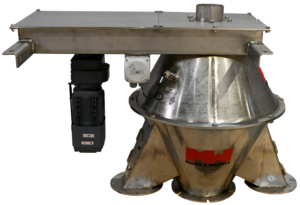VAD Product Brochure.
 To find out more about our Virtual Adjustable Divider (VAD) please feel free to download product brochure:
To find out more about our Virtual Adjustable Divider (VAD) please feel free to download product brochure:
Link to brochure
The Virtual Adjustable Divider (VAD) is designed for representative mass reduction of bulk material. The VAD can be used for mass reduction of virtually any type of dry materials.
The Virtual Adjustable Divider (VAD):
Find more of Mark & Wedell JAWO Sampling’s innovative sampling solutions here:
 To find out more about our Virtual Adjustable Divider (VAD) please feel free to download product brochure:
To find out more about our Virtual Adjustable Divider (VAD) please feel free to download product brochure:
Link to brochure

The Virtual Adjustable Divider (VAD) is designed for representative mass reduction of bulk material. The VAD can be used for mass reduction of virtually any type of dry materials.
The VAD is a robust, all-round sub-sampling solution. The VAD is used in many multi-stage sampling systems but may also be used as a stand-alone divider.
Variant 1
The Virtual Adjustable Divider Single (VAD-S) has one sample outlet in the bottom section. The outlet division ratio can be changes electronically from 10% – 90% of the inlet flow by means of input from the operator.
Variant 2
The Virtual Adjustable Divider Dual (VAD-D) has two sample outlets in the bottom section. The VAD-D is used where two aliquot analyses are needed for each sample (e.g. moisture, PSD, FE-content). For each outlets the division ratio can be changes electronically from 10% and up to 90% of the inlet flow.
The VAD consists of a drive unit, a rotating dividing pipe with a position sensor, a top cone with an inspection hatch, a bottom cone with a reject outlet and one sub-sample outlet also with an inspection hatch. The motor unit is connected to a pulley that drives the timing belt and rotates the dividing pipe.
In the bottom section, material is ducted to the periphery of the bottom cone’s inner wall where the sub-sampling division ratio via input from the operator is determined by starting/stopping of the motor. The non-sampled material passes directly to the reject outlet(s).
During each rotation, the tube can be stopped over the reject discharge outlet using a position sensor on the tube. The required division ratio is achieved by controlling the time spent by the tube in reject position – and thereby how often it passes over the sample outlet. The acceleration of the tube after it resumes rotation is fast enough to ensure that the material stream always travels through the sample outlet’s opening at uniform speed.
The VAD is based on the well proven JAWO RTD design and to provide an exact start and stop of the rotating tube the motor is equipped with a brake.
Options
Nota Bene
The VAD functionality can be retrofitted on almost any M&W RTD that is delivered after 2010. Subject to clarification.
Cookie Settings is not available. Cookie Consent is disabled or is just disabled for your country.